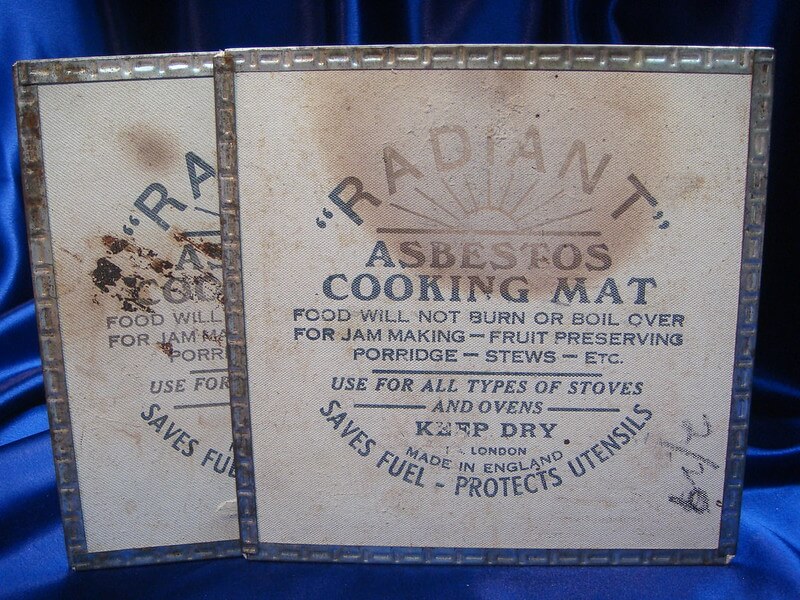Get Your Free Mesothelioma Guide

Find a Top Mesothelioma Doctor

Access Help Paying for Treatment

The United Kingdom possesses one of the highest rates of mesothelioma in the world, largely because the UK government permitted the use of asbestos long after other countries outlawed the mineral's use.
Get the best attorney today for you and your family, avoid the courtroom, and get the compensation you deserve:



The United Kingdom has one of the highest rates of mesothelioma in the world. The U.K. used brown asbestos and its government permitted the use of chrysotile asbestos years after other countries outlawed it.
Asbestos use in the U.K. began in the late 1800s to insulate ships, steam engines and power plants. By the 1970s, Britain used it in construction throughout the country. U.K. researchers were publishing studies on the dangers of asbestos as early as the 1930s. But it wasn’t until 1999 that the U.K. banned all types of asbestos.
I’m always on tenterhooks as I have a scan every two months [because] it can hold the future in my hands. If [the cancer is] growing again, I have another battle on my hands and more traveling and more drugs to fight it with. But when I get a good result, I go silent and just feel so grateful to Merck, the Royal Marsden and all the wonderful doctors.
Brown asbestos is also known as amosite. Insulation boards throughout the U.K. contained it. Researchers believe this type of asbestos contributes to Britain’s high rate of mesothelioma. It is more carcinogenic than chrysotile.
The Cancer Research UK and the Health and Safety Executive publishes cancer statistics regularly. In 2024, they reported that doctors diagnose about 2,700 new mesothelioma cases in the U.K. annually.
Most U.K. residents who die from the disease are older than 65. Men make up about 80% of people who receive a mesothelioma diagnosis in the U.K., which also fits the worldwide profile for this cancer.
Since the early 1990s, the U.K. mesothelioma incidence rate has increased by approximately 57%. The incidence rate in women increased about 93%, and the rate in men increased by 47% from 2016-2018. Women are often exposed to asbestos indirectly by living in areas near asbestos factories or living with people who worked with asbestos.
Get Your Free Mesothelioma Guide

Find a Top Mesothelioma Doctor

Access Help Paying for Treatment

Certain occupations required workers to use asbestos-containing products. They provided excellent protection from heat, salt water and chemical corrosion. These properties also make it difficult for the body to break down asbestos. This leads to an accumulation of asbestos fibers inside the body.
People in the U.K. who worked in the shipbuilding industry before the 1980s are at high risk for mesothelioma. Asbestos insulation and other asbestos products were on ships, so retrofitting, maintaining or repairing ships puts workers at risk of asbestos exposure. Construction workers in the U.K. are another high-risk group. Asbestos is prevalent in the country’s older buildings and residences. Structures erected or renovated before 2000 likely contain asbestos.
U.K. military veterans have a high rate of mesothelioma. Exposure occurred because the military used many asbestos products. Veterans need help navigating health and military systems for mesothelioma support and resources. A 2021 article in the European Journal of Oncology Nursing documented that veterans struggle to find support.
Women in the U.K. who used products containing asbestos-contaminated talc have developed mesothelioma. These products include personal hygiene products and cosmetics such as talcum powder, deodorant and makeup.
Terry Latham, originally from Oxfordshire, England, is one of America’s longest-living pleural mesothelioma survivors, an inspiration to many and a living testament to the expertise of thoracic surgeon Dr. Robert Cameron and his staff at the Ronald Reagan UCLA Medical Center. Latham, now in California, continues to thrive, overcoming myriad health issues that long ago would have sacked a less-determined man.
There has been a slight decrease in the number of deaths from mesothelioma in most of the country’s regions. The UK’s Health and Safety Executive, also known as HSE, reported this data. Rates for males in Wales resemble rates in Scotland. England documented higher rates. Unfortunately, an upward trend in deaths for women was found in all regions.
Asbestos was widely used in factories, chemical plants, power plants, refineries, commercial buildings and schools in the UK. Studies conducted in the past when asbestos was widely used show higher rates of mesothelioma around facilities that heavily used asbestos or produced asbestos products. Anyone working at these facilities or living nearby was at risk of inhaling asbestos fibers.
In the 1970s, it became apparent that cases of mesothelioma and other asbestos-related diseases were on the rise in England, Scotland, Wales and Northern Ireland. Legislators recognized it was necessary to take action to control and possibly ban the use of this toxic material, and hospitals realized they needed to account for people who required specialized treatment for this rare cancer.
Many buildings in the U.K. contained asbestos insulation, cement, shingles, siding, wallboard and tiles. Many structures still contain asbestos. They continue to present a danger when renovated or demolished.
Several thousand household and automotive products used by U.K. residents contained asbestos. Asbestos-contaminated talc products exposed women throughout the U.K. Women have developed mesothelioma through contaminated talcum powder and makeup products.
Exposure to household asbestos products is not considered as dangerous as working directly with asbestos products on the job, but it should still be avoided.
A few dozen producers of asbestos products may be responsible for the exposure of thousands of individuals to asbestos fibers. These companies employed tens of thousands of individuals who were likely exposed to asbestos on the job.

Companies such as Turner & Newall — based in Manchester — produced asbestos cloth, asbestos cement sheets and a variety of other products that made workers sick. Other U.K. asbestos product manufacturers include Cape Asbestos, Ferodo Limited, Marinite Co., John Brown and Company, JW Roberts Limited, Washington Chemical Company, TBA Industrial Products, Turners Asbestos Cement and Newalls Insulation Company Limited.
Not every hospital in the U.K. has mesothelioma specialists on staff. Prestigious hospitals throughout Britain offer mesothelioma specialists.
The Royal Marsden Hospital, located in London and Surrey, offers mesothelioma treatment. The Royal is also the oldest dedicated cancer hospital in the world. The hospital has the latest treatment options and conducts mesothelioma clinical trials.
St. George’s Hospital, University of London is home to Dr. Angus Dalgleish, a mesothelioma specialist who has been involved in clinical trials for mesothelioma in addition to serving as a medical oncologist for this rare cancer. The hospital is one of the largest in Europe and is known for its cancer care, cardiac care and bone marrow transplantations.
The U.K. doesn’t have as many mesothelioma clinical trials as the U.S. or Europe. These trials study a wide range of therapeutics. These range from immunotherapy to surgery. They’ve even studied radiation to help surgery scars.
Clinical trials are investigating targeted therapies, immunotherapy and chemotherapy. As well as methods to improve the diagnostic process.
The average compensation awarded in mesothelioma lawsuits in the United Kingdom ranges from £137,000 to £153,531. These figures come from a 2014 report by the U.K. Department for Work and Pensions.
The number of mesothelioma cases increased in the second half of the 20th century. The U.K. government began to acknowledge asbestos-related diseases of the lungs. Legislation is now in place to protect those affected by asbestos.
Determining who is liable is difficult because the disease can take 20 to 50 years to develop. Most of those diagnosed with mesothelioma worked for one or more companies that used asbestos.
A 2019 mesothelioma talc lawsuit filed by a U.K. woman decided that U.S. courts are the best venue for such claims.
In her lawsuit, Hanna Louise Fletcher claimed she developed mesothelioma at the age of 45 by using talc-based makeup and other talc products. Fletcher used her mother’s talcum powder as a child. She also purchased contaminated talc-based makeup during vacations in New York City.
You may think that living in the UK, you are not able to file a case within the U.S. court system, but that’s not entirely true. If you have [asbestos] exposure that relates back to American-branded companies or to products manufactured here in the United States, you may be able to avail yourself of a courtroom in the United States.
The judge ruled that her case should stay in New York because it remains the defendants’ principal places of business. Fletcher’s purchase of products in New York also influenced the ruling. U.K. women have received multimillion-pound verdicts since this ruling.

Patients and family members may be eligible to file a lawsuit after a mesothelioma diagnosis.
Get CompensationAsbestos prohibition laws in the United Kingdom were first introduced in the mid-1980s. In 1985, the U.K. banned the import and use of crocidolite and amosite, or blue and brown asbestos, respectively. This rule was replaced in 1992 with a law that also banned some uses of chrysotile asbestos, which is traditionally considered less lethal than the other forms of asbestos.
1999
Year the U.K. government banned the use and import of chrysotile asbestos.
Other asbestos-related laws passed during the 1990s stipulated that work on any asbestos insulation products may only be carried out by a licensed asbestos professional.
Asbestos-at-work regulations have set maximum exposure limits and require that all asbestos be identified and managed properly. Regulations also require that employees at risk for asbestos exposure be trained in asbestos safety precautions.
The U.K.’s Control of Asbestos Regulations Act combined the above legislation into one law prohibiting the use, supply, and importation of all asbestos to help prevent mesothelioma. This law prevents new uses of asbestos in the U.K. but allows existing asbestos-containing materials to remain intact if they are in good condition and undisturbed.
The 2006 act also set maximum exposure limits and demanded that anyone at risk of encountering asbestos on the job be trained to handle the material properly. Certain asbestos products and work activities relating to asbestos were outlawed in the U.K. by the Control of Asbestos Regulations Act, unless the products were manufactured before November 1999.
The Control of Asbestos Regulations 2012 Act updated previous regulations to comply with the European Commission’s opinion that the U.K. had yet to completely implement the European Union Directive on asbestos exposure.
This measure didn’t change prior regulations, but it added more requirements to improve the safety of non-licensed asbestos work. Such measures included reporting non-licensed asbestos work to the relevant enforcing authority, keeping written records of the work and having workers under medical surveillance.
The Asbestos Regulations of 1969 were the first U.K. laws designed to help control asbestos exposure in the workplace, but statutory control procedures were not introduced until nearly 20 years later when the Control of Asbestos at Work Regulations (1987) was put into effect.
In 1993, those laws were amended to make it mandatory to substitute other suitable, safer products for asbestos wherever possible. In 2002, the bill was amended again to require that all workplaces identify any existing asbestos-containing materials and manage them to ensure the safety of workers.
In 2009, Scotland passed the Damages Act to ensure the House of Lords ruling from October 2007 would not affect cases in Scotland.
The Damages Act allows compensation for individuals who have developed pleural plaques because of asbestos exposure. Insurers tried appealing the 2009 legislation, noting that plaques do not necessarily lead to poor health, but they lost on appeal in April 2011.
In 1983, the Health & Safety Executive, also known as HSE, passed legislation which stated that all contractors working with asbestos insulation or coating had to be licensed through the HSE. Asbestos insulation board was added to the list of license-required materials in 1998.
Under the 2006 Control of Asbestos Regulations, nearly all work involving asbestos insulation products must be performed by a licensed professional.
The law also states that work must be performed in accordance with the approved code of practice, and any plans for the removal of asbestos must be submitted to the HSE at least two weeks prior to the beginning of work.
The mission and vision of the Royal Society for the Prevention of Accidents (RoSPA) is to save lives, reduce injuries and lead the way on accident prevention. The organization, which started in 1916, has spearheaded pedestrian safety, analyzing accident causes, home safety guidelines and occupational health risk campaigns, including raising awareness of asbestos-related illnesses and how to prevent them.
The charity provides an asbestos training course that includes an explanation of the Control of Asbestos at Work Regulations 2012, as well as how to manage asbestos risks and understand the dangers of exposure.
RoSPA’s National Occupational Safety & Health Committee is a voluntary association of people drawn from organizations representing a broad cross-section of occupational safety and health interests.
It is an advisory committee to the RoSPA and helps identify the ways and means of improving occupational safety and health, while also shaping RoSPA policy and key issues. It also covers several topics, including asbestos and work-related cancer, as part of its Occupational Health Risks Campaigns.
Recommended ReadingYour web browser is no longer supported by Microsoft. Update your browser for more security, speed and compatibility.
If you are looking for mesothelioma support, please contact our Patient Advocates at (855) 404-4592
The Mesothelioma Center at Asbestos.com has provided patients and their loved ones the most updated and reliable information on mesothelioma and asbestos exposure since 2006.
Our team of Patient Advocates includes a medical doctor, a registered nurse, health services administrators, veterans, VA-accredited Claims Agents, an oncology patient navigator and hospice care expert. Their combined expertise means we help any mesothelioma patient or loved one through every step of their cancer journey.
More than 30 contributors, including mesothelioma doctors, survivors, health care professionals and other experts, have peer-reviewed our website and written unique research-driven articles to ensure you get the highest-quality medical and health information.
My family has only the highest compliment for the assistance and support that we received from The Mesothelioma Center. This is a staff of compassionate and knowledgeable individuals who respect what your family is experiencing and who go the extra mile to make an unfortunate diagnosis less stressful. Information and assistance were provided by The Mesothelioma Center at no cost to our family.LashawnMesothelioma patient’s daughter


Whitmer, M. (2025, April 8). Mesothelioma in the UK. Asbestos.com. Retrieved April 14, 2025, from https://www.asbestos.com/mesothelioma/uk/
Whitmer, Michelle. "Mesothelioma in the UK." Asbestos.com, 8 Apr 2025, https://www.asbestos.com/mesothelioma/uk/.
Whitmer, Michelle. "Mesothelioma in the UK." Asbestos.com. Last modified April 8, 2025. https://www.asbestos.com/mesothelioma/uk/.
An occupational scientist or another expert who specializes in occupational hazards reviewed the content on this page to ensure it meets current scientific standards and accuracy.
Arti Shukla, Ph.D., is an internationally renowned asbestos researcher known for her achievements in identifying biomarkers that cause mesothelioma. She is the director of the Shukla Research Lab, as well as a professor of pathology at The University of Vermont Larner College of Medicine.
Our fact-checking process begins with a thorough review of all sources to ensure they are high quality. Then we cross-check the facts with original medical or scientific reports published by those sources, or we validate the facts with reputable news organizations, medical and scientific experts and other health experts. Each page includes all sources for full transparency.
Please read our editorial guidelines to learn more about our content creation and review process.
